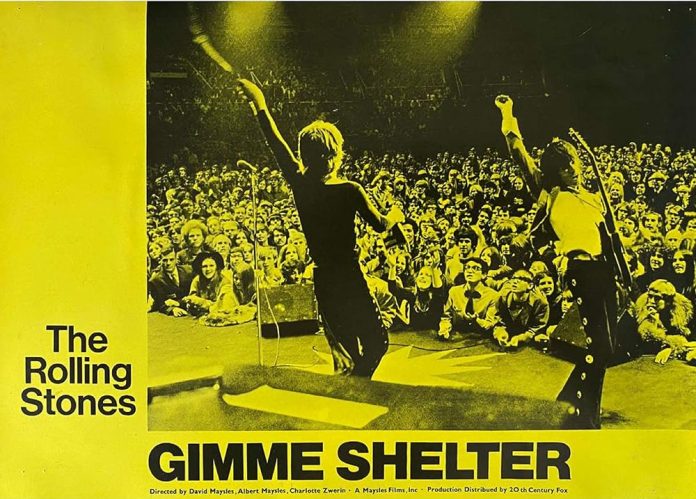A few months ago, Dylan Howell and I started 20th Century Catch Up, a movie-a-week series reviewing one film for every year from Taft to Y2K, which ended shortly. We decided to turn our planned personal project into an independent study and double dip on our weekly writings.
We’re honing in on the 1970s in American film, both as a reflection of life and an influence on culture. By focusing on one specific decade, we can narrow our analyses, noting particular aspects of film’s evolution as a reflection of America’s shifting cultural identity and distilling an argument for our final project: a podcast. Our independent study is by no means an “intro to film” course, but instead a deep dive into history, art, analysis, and argumentation. Get ready to ring in the new decade with those massive bell bottoms, because the country’s about to wake up from its American dream. Can you dig it?
WEEK 1 – Gimme Shelter (1970)
The Death of the ‘60s
Where to watch:
HBO Max
Content Warnings:
Moderate nudity, violence with frequent profanity, drug and alcohol use
Overview (by Sam):
Originally conceptualized as a 30-45 minute TV special promoting the Rolling Stones and documenting their 1969 tour, Gimme Shelter ultimately became a sobering dissection of the dawn of a new decade: one of cynicism, decay, and the purported death of the 1960s’ dream. Their notorious free concert at the Altamont Speedway in Alameda County, California, intended as a glorious tribute to humanity’s good nature, quickly became a violent failure, with “four births, four deaths, and an awful lot of scuffles reported.” The documentary is composed of footage from many different camera people and manages to perfectly capture the moment in artistic composition.
The most interesting part of this whole production is its framing. We begin in a studio with the Rolling Stones and several others listening back to a recorded statement by one of the Hells Angels present at the Altamont concert, rationalizing his brutal violence towards the ‘flower people’ who reportedly kicked over his bike. The Stones sit in grim defeat as they watch the footage from the concert that will soon be shared with the audience. Each member of the band is introduced one by one with a plain white text overlay. Finally, we get their perspective as the camera zooms in on one monitor: our title drop.
The first third of Gimme Shelter is about the previous weekend’s Madison Square Garden concert and the Rolling Stones recording Wild Horses in Muscle Shoals, acting as a successful “control” concert. You can see hints of foreshadowing when people climb up onstage while under the influence. We make it to Altamont about halfway through and the documentary changes face. The concert’s massive scope is captured with helicopter footage showing cars backed up for miles as throngs of pilgrims billow across the California plains. Members of the crowd are primarily hippies, with a few blue collar men here and there. As the night progresses and the situation intensifies, fights break out at the beginning of every song. Performers admonish, beg, and plead their audience to practice what they preach until the infamous stabbing of Meredith Hunter, after which the Stones continue playing like nothing happened. The movie sits in silence for some time as the sun rises on a new era and thousands of people return to their lives as a new decade dawns.
Sam’s part:
Gimme Shelter, named after my personal favorite Rolling Stones song off the album Let It Bleed, presents such a refined and singular narrative that it’s easy to forget it’s a documentary and not scripted and staged. One year after the assassinations of Dr. Martin Luther King, Jr. and Robert Kennedy, the same year as man set foot on the moon, the great 60s experiment came to a violent end.
For the most part, Gimme Shelter is a compilation of concert footage with some neat behind the scenes stuff. While the Stones prepare for their Madison Square Garden concert (Ike and Tina Turner opened), the camera lingers on Mick Jagger’s emaciated torso, echoing in the haunting still of his face before the credits roll. Themes of drug abuse and alcoholism crop up throughout, from Keith Richards’ excessive drinking to acid-dropping concertgoers. The 4:3 aspect ratio makes it so faces fill the screen and actually brings the whole experience closer to an album cover than a movie.
This documentary captured several images that perfectly encapsulate the mood, the best of which is a Hells Angel death stare about an hour in. His eyes shoot daggers at the Stones with an unsettling fire behind them, juxtaposing the upbeat, hopeful songs blasting out into the desert.
Gimme Shelter and its 1970 sibling Woodstock would set the model for “rockumentaries” and other concert films, and I’d certainly recommend it if you’re a Rolling Stones fan.
Dylan’s part:
I am certainly more of a fan of The Beatles than The Rolling Stones. I have studied The Beatles and listened to their albums and most of the four’s solo work. However, with the Rolling Stones, I have only heard their more popular songs in passing. I think looking at the start of the ‘70s by comparing The Beatles and The Rolling Stones works very well, especially when that comparison includes their documentary films from 1971 and 1970, respectively. With The Beatles, many have said they were an encapsulation of the 1960s in America and Britain. This time of peace activism and experimentation has been romanticized. But The Rolling Stones were this “darker” and “edgier” take on boy bands at the time. Different from The Beach Boys and The Beatles, they were a band for the 70s. Gimme Shelter depicts this in a very disturbing way. Gimme Shelter functions as the death of the ideals and romanticization of the ’60s and shows that no matter how late you stay up in the peace march striking against the government or fighting for rights, eventually, you have to go home. The System still stands, and you have to go back home and fight it from there, and that is where the change mainly occurs. The Rolling Stones tried so hard to put on a free concert for people, which is essentially the 60s. But the crowds were continuously violent and refused to follow the requests of the band and those that put on the concert. There were four deaths during the concert but just as many births. I feel it truly says a lot about the desperation in the decade that would follow their concert. Known for its cynicism and nihilism is the decade that would bring us the film that made us believe a man could fly, the idea of a blockbuster, and Star Wars.



